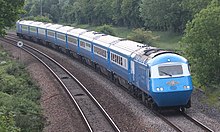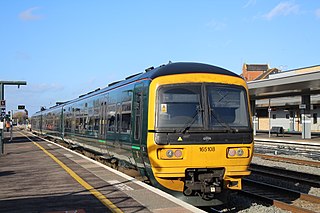| Blue Pullman | |
|---|---|
 Blue Pullman at Swansea station in 1967 | |
 Interior of Blue Pullman | |
| In service | 1960–1973 |
| Manufacturer | Metropolitan-Cammell |
| Family name | Blue Pullman |
| Replaced | Steam locomotives and carriages |
| Constructed | 1959–1960 |
| Entered service | 12 September 1960 |
| Refurbished | 1969 |
| Scrapped | 1974–1975 |
| Number built | 5 sets (2 × 6-car; 3 × 8-car) |
| Number scrapped | All |
| Successor | Separate locomotives and Mark 2 coaches |
| Formation | 6 or 8 cars per set |
| Fleet numbers |
|
| Capacity | 6-car sets: 132 8-car sets: 218 |
| Operators | British Rail |
| Depots | |
| Lines served | 6-car sets: London Midland Region (1960-1967) and Western Region (1967-1973) 8-car sets: Western Region |
| Specifications | |
| Car body construction | Steel Semi-integral |
| Train length | 395 ft (120.40 m) (MR) 545 ft 1 in (166.14 m) (WR) |
| Car length | 66 ft 5.5 in (20.26 m) (power cars) 65 ft 6 in (19.96 m) (intermediate vehicles) |
| Width | 9 ft 6 in (2.90 m) |
| Height | 12 ft 4.5 in (3.77 m) |
| Doors | Hinged slam, centrally locked |
| Maximum speed | 90 mph (145 km/h) |
| Weight | 6-car sets: 299 long tons (335 short tons; 304 t) 8-car sets: 364 long tons (408 short tons; 370 t) |
| Prime mover(s) | NBL/MAN V12 Supercharged 64L(×2) |
| Power output | 1,000 hp (750 kW) (×2) |
| Transmission | traction motors: 199 hp (148 kW) (×8) |
| Auxiliaries | 2× Rolls-Royce C8NFLH @ 190 bhp, under floor for air conditioning [1] |
| UIC classification | 6-car sets: 2′Bo′+Bo′2′+2′2′+2′2′+2′Bo′+Bo′2′ 8-car sets: 2′Bo′+Bo′2′+2′2′+2′2′+2′2′+2′2′+2′Bo′+Bo′2′ |
| Bogies | Metro-Schlieran frictionless |
| Braking system(s) | Westinghouse Electro-pneumatic brake featuring a high speed control |
| Multiple working | 2 sets (6-car units (1967-1973) |
| Track gauge | 4 ft 8+1⁄2 in (1,435 mm) |
The Blue Pullmans were luxury trains used from 1960 to 1973 by British Rail. They were the first Pullman diesel multiple units, incorporating several novel features.
Contents
- History
- Inception
- Services
- Withdrawal
- After service
- Design
- Livery
- Technical details
- Formation
- Recreations
- In film
- Models
- See also
- References
- Bibliography
- Further reading
- External links
Named after their original Nanking blue livery, the trains were conceived under the 1955 Modernisation Plan to create luxury diesel express trains aimed at competing with the motor car and the emerging domestic air travel market. Although not entirely successful – they were seen as underpowered, and ultimately not economically viable – they demonstrated the possibility of fixed-formation multiple-unit inter-city train services, that a decade later was developed as the InterCity 125, which resembled them in having an integral power car at each end of the train.
There were two versions, built by Metro-Cammell in Birmingham: two first-class six-car sets for the London Midland Region (LMR), and three two-class eight-car sets for the Western Region (WR). They were initially operated by the luxury train operator the Pullman Car Company, which the British Transport Commission (BTC) had acquired in 1954. Shortly after their introduction, in 1962, the Pullman Car Company was incorporated into the British Railways network. Originally given the last Pullman vehicle numbers, towards the end of their operational life the trains gained the British Rail TOPS classification of Class 251 (motor cars) and Class 261 (kitchen and parlour cars), although they never carried these numbers.
The WR sets operated from London Paddington to Birmingham and Wolverhampton, and to Bristol, Cardiff and Swansea. The LMR sets operated the Midland Pullman between London St Pancras and Manchester Central via the Midland Main Line, a journey it accomplished in a record 3 hours 15 minutes with a maximum speed of 90 miles per hour (140 km/h). [2] The Midland Pullman was withdrawn in 1966 following electrification of the Euston to Manchester line, which brought greatly reduced journey times with which the Midland route could not compete. The LMR sets were then transferred to the WR, where some of the first-class seating was downgraded to form two-class sets.
The sets were an advanced and luxurious design, befitting a Pullman train, although they did suffer some criticism particularly over a persistent ride quality problem. Over time it became costly to maintain such a small fleet of trains. By 1972, with the development of first-class accommodation in Mark 2 coaching stock, the surcharge for Blue Pullmans seemed uneconomical and unreliable to passengers and BR managers, and in 1973 the trains were withdrawn. None were preserved.
The sets featured in three films, one of the same name as a documentary of the design and development, and an observation of the first service. From 2006, the Blue Pullman name was revived as a charter railtour, operated by various companies.






















